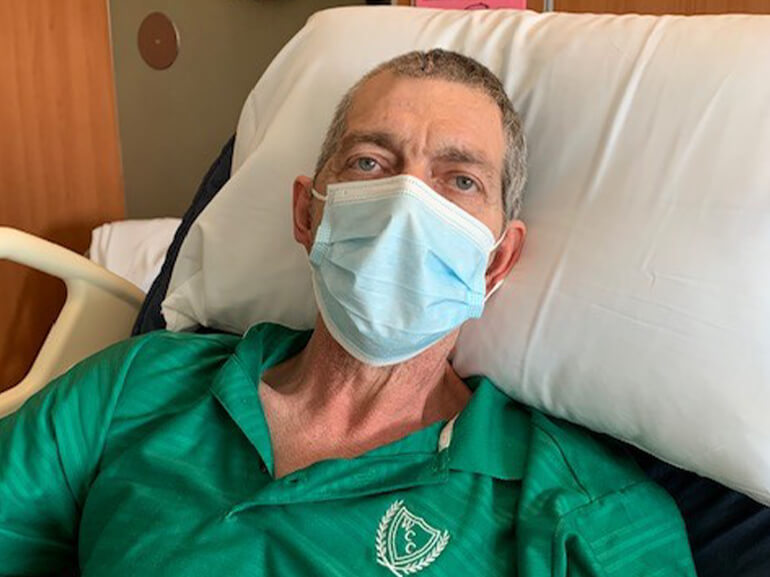Michael's story

St. Louis native Michael “Mike” Brown, 60, is a proud husband, father of four and a grandfather. At age 22, Mike was diagnosed with muscular dystrophy, a group of genetic diseases that cause progressive weakness and loss of muscle mass.
Despite having dealt with more than his fair share of health challenges over the years, Mike remained as active as possible. After a day spent babysitting his granddaughters, he returned home and went to bed. That night, he fell out of bed and hit his head on the floor, cutting it open. His wife quickly called an ambulance that took him to SSM Health DePaul Hospital.
Imaging and testing done at the hospital showed Mike had suffered a stroke and was experiencing bleeding in his brain. To relieve the extra pressure on his brain, doctors performed a craniectomy, a type of surgery that removes a portion of the skull. The stroke left Mike unable to eat or drink, so a feeding tube was placed to provide nutrition. The combination of the stroke and muscular dystrophy severely affected the left side of Mike’s body, leaving him with no movement in his left leg and limited use of his left arm. His visual and spatial awareness on his left side were also impaired and he struggled to speak and focus on tasks.
After Mike’s brain swelling had healed sufficiently, he underwent a cranioplasty to replace the portion of his skull that was removed immediately after his stroke. When he was stable enough to be moved, Mike was transferred to SSM Health Rehabilitation Hospital – Bridgeton, to continue his recovery. The hospital’s location was ideal for Mike, as it was close to his home and allowed for easy family visits.
Upon admission, Mike required full assistance to stand and transfer positions. He was also completely reliant on others for his self-care and was still receiving nutrition through a feeding tube. Mike’s goals were to regain the use of his leg and arm and eat solid food again. His physician-led team of nurses and physical, occupational and speech therapists created a plan for his recovery.
Physical therapists focused on improving Mike’s balance, strength, walking and ability to transfer from laying to sitting to standing. As a result of his stroke, Mike was suffering from “Pusher Syndrome,” which is when a stroke patient uses their stronger arm to push themselves towards the weaker side while sitting and standing. This condition is also accompanied by visual impairments and inattention to one side, which can significantly affect the patient's ability to sit or stand upright, thus increasing risk for falls.
Therapists also helped Mike re-learn to walk using a body-weight assisted gait trainer, a device that uses a harness to assist patient in maintaining upright posture and balance while allowing therapist to focus on improving lower extremity movement and walking efficiency.
In occupational therapy, Mike and his therapists worked on self-care retraining, including hemi-dressing techniques, which teach the patient to dress their weaker side first and when undressing take the clothes off the weaker side last. Mike was very excited to take a real shower and therapists helped him accomplish this by using a shower chair that titled back to keep him safely positioned. Occupational therapists also assisted Mike with visual retraining to improve his awareness and attention to the left side of his visual field through fun activities including word searches. They also utilized the Bioness Integrated Therapy System (BITS), an interactive touch-screen therapy device to improve hand-eye coordination, reaction time, depth perception and working memory. In addition, therapists guided Mike through range of motion exercises with his left arm to improve his movement and strength.
Speech therapists assessed Mike’s ability to swallow safely by conducting a modified barium swallow study then completed trials with various food textures and liquids to transition Mike back to a regular diet. Therapists also worked with Mike on various tasks to improve his attention by using card games, visual scanning strategies and sequencing cards.
During his time at SSM Health Rehabilitation Hospital – Bridgeton, Mike had to be readmitted to the acute care hospital on two occasions due to complications. Despite those setbacks, his therapists said each time he returned to rehabilitation, Mike was always motivated and ready to tackle any task presented to him.
After nearly four weeks of intense rehabilitation, Mike had made great improvements. He was able to eat a regular diet, drink thin liquids and take all medications orally. His attention toward conversation and tasks had improved, including the ability speak and be understood. The movement and strength of his left arm had improved to the point where he was able to perform self-care tasks and transfers with minimal assistance. Mike was able to go up and down 12 steps with minimal assistance and could walk short distances of up to 100 feet without an assistive device and up to 300 feet with a wheeled walker.
Mike said that a turning point in his recovery when his wife was able to visit and see how much progress he’d made. Mike’s experience provided him with unique insight for other individuals who are going through recovery, sharing: “Listen to your doctors and nurses. Take one step at a time, and don’t rush your treatment because you don’t want to get out of the hospital before you’re ready. You don’t want to get out and fall and hurt yourself and then have to go right back in the hospital. It is good to have a supportive family to help you get through the emotional part of everything.”
With plans to continue his recovery with outpatient therapy, Mike said that he was looking forward to returning home, seeing his family and eating a sandwich from Chick-fil-A.